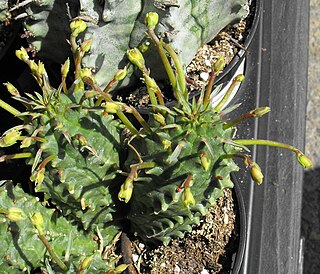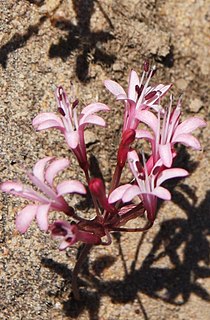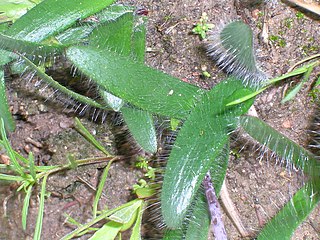
Vallisneria is a genus of freshwater aquatic plant, commonly called eelgrass, tape grass or vallis. The genus is widely distributed in tropical and subtropical regions of Asia, Africa, Europe, and North America.

Spiranthes spiralis, commonly known as autumn lady's-tresses, is an orchid that grows in Europe and adjacent North Africa and Asia. It is a small grey-green plant. It forms a rosette of four to five pointed, sessile, ovate leaves about 3 cm (1.2 in) in length. In late summer an unbranched stem of about 10–15 cm (3.9–5.9 in) tall is produced with approximately four sheath-shaped leaves. The white flowers are about 5 mm (0.20 in) long and have a green spot on the lower lip. They are arranged in a helix around the upper half of the stalk. The species is listed in Appendix II of CITES as a species that is not currently threatened with extinction but that may become so. Autumn lady's-tresses are legally protected in Belgium and the Netherlands.

Pandanus spiralis is native to northern Australia. It is commonly called common screwpine, iidool, pandanus palm, screw pine, screw palm or spring pandanus. It is neither a true palm, nor a pine.

Veitchia is a genus of flowering plant in the family Arecaceae.

Euphorbia spiralis is a species of plant in the family Euphorbiaceae. It is endemic to Yemen.

Macrozamia spiralis is a species of cycad in the family Zamiaceae. It is endemic to New South Wales in eastern Australia, where it is found in sclerophyll forest on low-nutrient soils. Plants generally lack a trunk and have 2–12 leaves that range up to 100 cm (40 in) in length.
Spirotecoma is a genus of plants in the family Bignoniaceae.
Strumaria barbarae is a species of plant native to Namibia and to Cape Province in South Africa. Its natural habitat is rocky areas.

Strumaria is a genus of African plants in Amaryllis family, subfamily Amaryllidoideae. The genus is known in nature only from South Africa, Lesotho and Namibia. Species flower in the autumn and are cultivated as ornamental bulbous plants.
Strumaria hardyana is a species of plant that is endemic to Namibia. Its natural habitats are subtropical or tropical dry shrubland and rocky areas.
Strumaria phonolithica is a species of plant that is endemic to Namibia. Its natural habitats are subtropical or tropical dry shrubland and rocky areas.

Vallisneria spiralis, also known as straight vallisneria, tape grass, or eel grass is a common aquarium plant that prefers good light and a nutrient rich substrate. In the wild, it can be found in tropical and sub-tropical regions worldwide.

Oxalis spiralis, the spiral sorrel, is a species of plant of the genus Oxalis, a member of the wood sorrel family Oxalidaceae.

Ficinia is a genus of tufted or rhizomatous sedges. There are around 70 recognised species in Africa, four species that occur in New Zealand and a single species Ficinia nodosa that occurs in Australia.

Chamaescilla is a genus of Australian herbs in the subfamily Hemerocallidoideae within the asphodel family. They have grass-like basal leaves and tuberous roots. The flowers have six petals and six stamens. The seed capsules contain black, glossy seeds.

Hessea is a genus of bulb-forming plants in the Amaryllis family native to Namibia and South Africa. The genus name commemorates C. H. F. Hesse (1772–1832), who resided in Cape Town from 1800 to 1817.

The Paradisus Londonensis is a book dated 1805–1808, printed by D.N. Shury, and published by William Hooker. It consists of coloured illustrations of 117 plants drawn by William Hooker, with explanatory text by Richard Anthony Salisbury.

Amaryllideae are a tribe of subfamily Amaryllidoideae. They are herbaceous monocot perennial flowering plants with a predominantly Southern African distribution, with the exception of the pantropical genus Crinum. They are generally treated as consisting of four subtribes. In addition to Crinum, other genera include Amaryllis, Boophone and Strumaria.

Strumaria chaplinii is a species of bulbous flowering plant in the family Amaryllidaceae, native to south-west Cape Provinces. It was first described in 1944 as Hessea chaplinii.














